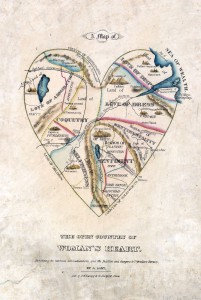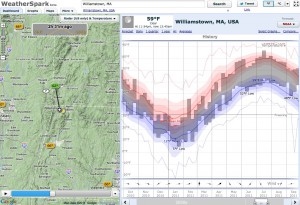And ART.
http://www.ted.com/talks/nathalie_miebach.html#.TqH0J36xzfk.facebook
I think this is a fascinating look at ways that one can visualize something (or map it), then create art from that visualization.
Hope you enjoy.

And ART.
http://www.ted.com/talks/nathalie_miebach.html#.TqH0J36xzfk.facebook
I think this is a fascinating look at ways that one can visualize something (or map it), then create art from that visualization.
Hope you enjoy.
Circa 1833-42. “Exhibiting its internal communications and the facilities and dangers to travellers therein.” Purports to be written by A Lady, but that seems unlikely. I’d say it’s probably authored by a man who’s perhaps spent too much time in the Region of Platonic Affection or the Tenting-Ground of Uncertainty. Poor guy. 
(click to enlarge, then zoom in. it’s worth it)
You have to see this video – like mapping the void.
 WeatherSpark is an excellent weather data visualization tool, including radar map video, temperature histories, forecast, daily averages, historical trends, and comparative weather charts…And very attractively presented.
WeatherSpark is an excellent weather data visualization tool, including radar map video, temperature histories, forecast, daily averages, historical trends, and comparative weather charts…And very attractively presented.
Here’s the WeatherSpark map of Williamstown.
 A pretty amazing map-cum-timeline of subway ridership from 1905 to 2006, displays with either lines or dots, and allows you to scrub forward and back in time. Also check out his original blog post about making the map, and the underlying data that he got from the blog frumination (which is also pretty great, the blog of a grad student in transportation and operations research.)
A pretty amazing map-cum-timeline of subway ridership from 1905 to 2006, displays with either lines or dots, and allows you to scrub forward and back in time. Also check out his original blog post about making the map, and the underlying data that he got from the blog frumination (which is also pretty great, the blog of a grad student in transportation and operations research.)
We talked about how the NYC subway map distorts the proportions and cardinal orientation of Manhattan to serve the needs of the map — laying out all of the info on the page, fitting the whole system on the map, graphical clarity. But a subway is just a line with points — from the viewpoint of the subway rider you just need to know how many stops until you transfer to the green line, then which direction to take (binary decision) and then how many stops until you get off. You don’t need to know that the F train makes a 90° turn after W. 4th, just that 2nd Avenue stop is two stations later. When leaving the subway you do need a planar map for negotiating the grid, but in the tunnels a line will do.
So if that is the case, why make the subway map resemble its geographical reality at all? Why not let it become something else, something symbolic or representative of structures and organizing principles unburdened by physical reality?…
Continue reading
Visual maps of languages are fascinating to me, since they chart so many other things — cultures, ethnic groups, historical events (invasions, immigrations and emigrations, royal marriages and other forced mergers) and more. This one is great because it maps it to words for geographical features; I’m amazed at how well it clusters! It also reminds me of how confused I was when I first moved to the northeast at the preponderance of “-kills” in the Hudson River Valley (Peekskill, Catskill, Fishkill — lots of animals being killed…) until someone explained it to me.
This map charts the rich variety of waterflow toponyms in the US, which reflects the climatological and geographical diversity of the country, but also its linguistic and historical heritage. River names seem extremely resistant to change, and indeed often are echoes of earlier dominant cultures [1].
The colours on the map, which is based on the place names in the USGS National Hydrography Dataset, correspond to the generic toponyms for waterflows, excluding the two commonest ones (river and creek, rendered in gray).
via 531 – A Rio Runs Through It: Naming the American Stream | Strange Maps | Big Think.
I definitely recommend clicking through and reading the whole post, which includes more explanation of each color and word (and word origin.)